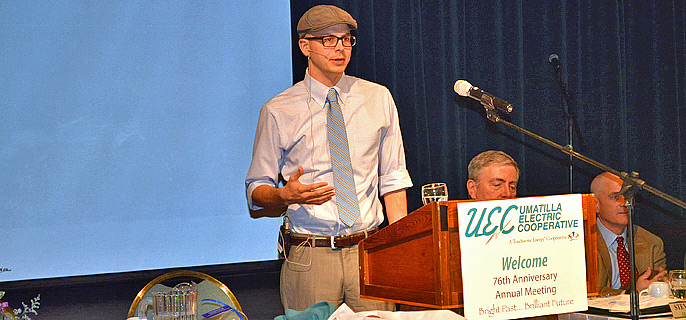
As any science fiction fan knows, if you see a robot with red eyes glowing at you, turn and run the other way as fast as you can. The red eyes are a dead giveaway that the robot means you – and the rest of humanity – no good.
Evil robots have been a fixture in the world of sci-fi since the genre’s beginning. But, according to Daniel H. Wilson, there is far more fiction than actual science to evil robots. The reality is robots have always existed to help humans and it’s only in books and movies that they ever turn on us.
“I studied robotics for six years in Oklahoma and never once was there a robot rebellion in the lab,” said Wilson, the featured speaker Saturday at Umatilla Electric Cooperative’s 76th Annual Meeting.
And yet, the image of the rogue robot is pervasive throughout popular cultures. From Hal 900 in 2001: A Space Odyssey to Gort, the humanoid robot in The Day the Earth Stood Still, the robot has often been portrayed as something to fear. One reason, said Wilson, is we tend to fear new technology.
“We take all our fears of technology and project them onto the robot,” he said. Wilson, 35, is a robotics engineer and novelist. He admits he is as guilty as anyone is perpetuating society’s fear of robots. His novel, Robopocalypse, is about a robot that is intent on the elimination of the human race. Plans are in the works to adapt the book into a film with Steven Spielberg directing.
Another reason for the robot’s bad reputation is the simple fact that nobody owns an intelligent, functional robot, said Wilson.
“No one has their own robot walking the dog,” he said. But, said Wilson, that could happen in the future. He sees two types of likely robots in the future that could be designed to make life easier for humans. One is a self-driving car for which, in part, the technology already exists. Vehicles are being sold today that do the parallel parking for the driver. Wilson sees technology going several steps further.
There are 250 million registered passenger vehicles in the United State – a frightening figure, he said, when you consider that “we are horrible drivers.
“There are 11 million traffic accidents each year in the U.S. They are the leading cause of death for people age 10 to 24. It’s pretty much a slaughterhouse out there.” If cars could drive themselves, we’d all be better off, Wilson said.
The other likely robot is one that does simple household chores for us, sort of like Rosy the robot from The Jetsons cartoon, except without the attitude. Prototypes for this sort of robot already exist, such as Honda’s ASIMO and Willow Garage’s PR2.
But before they become commonplace, Wilson said robots designed to assist humans will have to be affordable and be built “so they won’t kill us.” Robots can be dangerous, he said, not because of any sudden desire to cause harm, but because humans naturally find ways to get hurt by their own creations.
“They’d be tough to idiot-proof,” he said. “Put any object in front of a human and they will find a way to get hurt or killed.” One way to cut down on the number of accidents and fatalities caused by robots, said Wilson, would be to design them so they are small, light and weak – essentially incapable of hurting anyone even if they did turn psycho.
By building on technology already in use in personal computers and smart phones, Wilson said robots will eventually become commonplace in our society. Wilson predicts that robots will be used to empower small business owners, allowing them to mass produce products and carry out jobs that would normally require a large workforce.
“I’m looking forward to seeing what people will do with this technology,” he said. “The time for the robot uprising is over. The time when robots change our lives in a positive way is at hand.”








